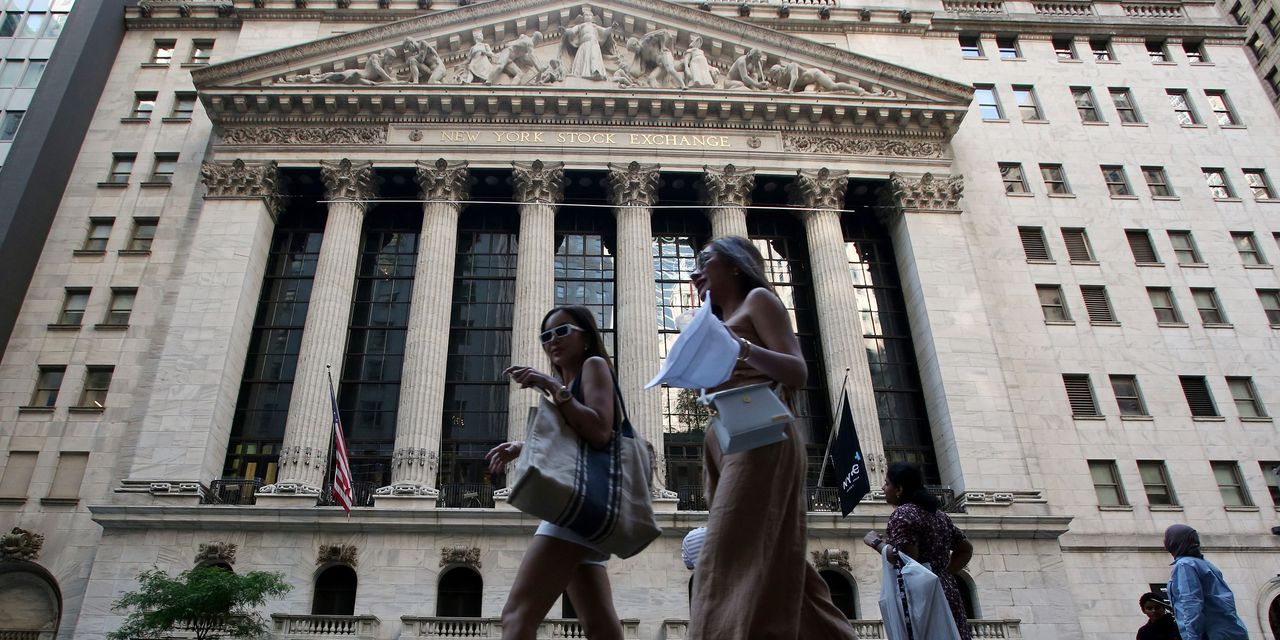Call it the “What, me worry?” stock market.
Nothing could faze U.S. stock indexes during the first six months of 2023—not the Federal Reserve, not a series of bank failures, not geopolitics, not even the down-to-the-wire debt-ceiling drama in Washington. And certainly not the fact that a recession felt like it was always just around the corner. Many professional prognosticators overlooked the enduring strength of the U.S. labor market.
Still, investors might just rediscover some nagging concerns during the second half of the year.
The
S&P 500
rose 2.35% this past week to finish the first half of 2023 up 16%, its best first half since 2019 and at a 52-week high. But there wasn’t a lot to write home about for much of the market. The average stock in the S&P 500 is up 6% year to date, while the small-cap
Russell 2000
has advanced only 7%. The
Dow Jones Industrial Average
and the
Russell 1000 Value index
gained less than 4%.
None of that matters, though, when Big Tech is rallying like it’s 2020.
Apple
(ticker: AAPL), which hit a $3 trillion market capitalization on Friday, has gained 48% year to date, while
Nvidia
(NVDA) has surged 189%. Add in a half-dozen other tech giants, and the Nifty Eight have returned an average of 85% this year, accounting for the bulk of the market’s positive performance. The
Nasdaq Composite
soared 32% in the year’s first half, its best start since 1983. It’s great for tech investors, but painful for just about everyone else.
“It’s a challenging time for valuation-sensitive stockpickers resistant to chasing a handful of high-multiple companies,” says David Donabedian, chief investment officer at CIBC Private Wealth US.
There are two ways things could go in the second half: Either the rest of the S&P 500 catches up to the megacap eight and the gains continue by broadening out, or the market leaders join the S&P 492 and the rally fizzles. For the former to happen, the market would need that fabled soft landing, in which inflation comes down to a 2% annual rate without a major hit to growth. That gets harder to imagine the longer that inflation remains elevated and the Fed keeps raising rates.
“The Fed is not going to come to the rescue this time,” says Wei Li, BlackRock’s global chief investment strategist.
But one doesn’t have to believe the doomsayers to lean into caution—just look at valuations. The S&P 500 trades at 19 times expected earnings over the coming year, up from 15 times in October, as stocks have gained even as earnings estimates have fallen. With a valuation that high, the risk/reward trade-off at the index level doesn’t appear all that attractive from here, at least in the short term.
That’s especially true if earnings estimates are too high given the recession risk, which would make stocks even more expensive than they already appear.
“The market may be due for a pause, or even a pullback, as the Fed continues to raise rates into a slowing economy,” says CIBC’s Donabedian.
In a potentially weaker second half of 2023, UBS strategists including Bhanu Baweja expect valuations to fall before earnings due to the Fed’s continued monetary tightening, the deterioration of credit conditions, and other factors. “We likely don’t have to wait for the onset of big earnings downgrades to see lower equities,” Baweja writes.
It’s a setup calling for a bit more caution from here. Quality companies that can maintain their pricing power and profit margins in a macro environment of slowing inflation and growth are a good bet. The
iShares MSCI USA Quality Factor
exchange-traded fund (QUAL) is one option there. Its top holdings include many of the tech megacaps that won 2023’s first half, plus stocks like
Visa
(V),
Nike
(NKE), and
ConocoPhillips
(COP).
Or investors can just take some money out of stocks and put it into bonds, where short-term U.S. Treasuries remain the fattest pitch for the year’s second half. The six-month T-bill yields a risk-free 5.5% today. It can be purchased directly from the U.S. Treasury at TreasuryDirect.gov or via the
US Treasury 6 Month Bill
ETF (XBIL). Locking that return in today may appear prudent six months from now.
By then, we’ll be looking ahead to the 2024 economic outlook and discussing the potential implications of a high-stakes U.S. election year. And maybe the market won’t have shrugged it all off so easily.
Good active managers should find it easier to beat their benchmarks when, as now, there’s more action under the surface than at the index level.
Indeed, actively managed stock mutual funds and exchange-traded funds as a whole outperformed their passive benchmarks in 2023 through late June, per data from Morningstar Direct.
That’s in contrast to most periods. Some 47% of actively managed large-cap mutual funds outperformed their benchmark in all of 2022, which was the best year since 2017, according to BofA Securities data. There are some star stockpickers out there, but, collectively, fund managers have tended to lag passive strategies.
Actively managed ETFs have proliferated in the U.S. to more than 1,000 since the Securities and Exchange Commission implemented rule changes in 2019. Unlike mutual funds, the portfolios trade like any other stock or ETF—meaning they can be sold short. Perhaps there’s a pair trade there: Short a given active ETF and buy a passive ETF that tracks its benchmark index. If the active fund underperforms, investors pocket the difference. Replicate the approach across a large basket of ETFs, and the historical record is on your side.
For now, active managers are finally beating the index in an environment that’s made for stock-picking. Over the long term, investors may be better served betting against them than alongside them.
Write to Nicholas Jasinski at [email protected]
Read the full article here











